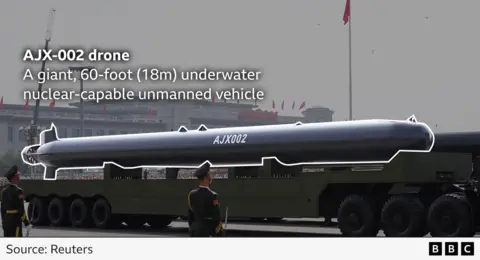China showcases new missiles, drones and robotic systems in massive parade, signaling growing military confidence
Beijing displayed a range of advanced systems — from a new ICBM and the so-called “Guam killer” missile to autonomous drones and robotic canines — in a show aimed at global audiences
China presented a diverse set of new weapons, drones and robotic systems at a large military parade on Wednesday, a display officials and analysts say was intended as a signal of Beijing’s expanding military capabilities and international standing.
The event, hosted by President Xi Jinping and attended by more than 20 foreign leaders including Russia’s Vladimir Putin and North Korea’s Kim Jong Un, showcased ground-launched missiles described by state media as intercontinental ballistic missiles, a long-range anti-ship missile nicknamed the “Guam killer,” a manned-unmanned teaming “loyal wingman” drone and autonomous robotic "wolves." Organizers said the lineup highlighted advances in production and technological sophistication across several service branches.

Analysts said the parade demonstrated China’s ability to mass-produce a wider array of systems than a decade ago. Michael Raska, an academic who studies military transformation, has observed that much of China’s earlier hardware resembled rudimentary copies of more advanced foreign designs; this year’s display, he and other observers say, reflects greater indigenous development and diversification of capabilities.
Parades, however, show inventory and production capacity rather than operational readiness. Experts cautioned that a public procession of tested prototypes and production models does not provide a full picture of how rapidly new systems can be deployed in combat, how they would perform under stress, or the numbers and sustainment needed for sustained operations. Independent verification of performance, training levels, logistics and battlefield integration typically requires separate demonstrations, exercises and intelligence assessments.
The new systems reflect a range of priorities for China’s armed forces. Long-range rocket and missile systems aim to extend deterrence and target maritime assets at greater range, while advances in drones and manned-unmanned teaming support both reconnaissance and strike options. Robotic ground systems on display suggest investments in autonomy for tasks including logistics, surveillance and force protection. State commentary framed the parade as both a celebration of military modernization and a warning to foreign powers perceived as threats to China’s interests.
Observers also noted the diplomatic dimensions of the event. Hosting dozens of foreign leaders while displaying high-end military hardware served a dual purpose: signaling Beijing’s international influence and underscoring geopolitical relationships with partners that appeared prominently in the stands. The attendance of leaders reliant on Chinese economic or political support drew attention to how military spectacle can be paired with broader foreign-policy messaging.
Questions remain about how many of the new systems are in frontline units, how they will be integrated into existing command-and-control structures, and when or whether they will be fielded in quantities sufficient to change regional military balances. Analysts pointed to the difference between demonstrable engineering progress — such as new prototypes and production lines — and the institutional steps required for operational capability, including doctrine, training, maintenance and secure logistics.

The parade followed years of sustained investment in China’s defence industrial base and came amid heightened tensions with the United States and some of its allies over Taiwan, the South China Sea and regional security. Western officials increasingly assess that Beijing is accelerating modernization across air, naval, space and missile forces, while Beijing describes the upgrades as necessary to protect sovereignty and deter external interference.
Military displays have historically served multiple purposes: reassuring domestic audiences about national strength, deterring potential adversaries by making capabilities visible, and promoting exports by demonstrating advanced hardware to possible buyers. In Beijing’s case, the combination of new systems and a high-profile guest list magnified the international visibility of that messaging.
Analysts said future assessments of China’s military trajectory will depend on observable indicators beyond parades: frequency and scale of exercises, export and production data, satellite and open-source monitoring of deployments, and official statements about doctrine and force structure. For now, the parade provided a clear public demonstration of China’s evolving arsenal and an unmistakable signal about the country’s intent to project both military and diplomatic influence.